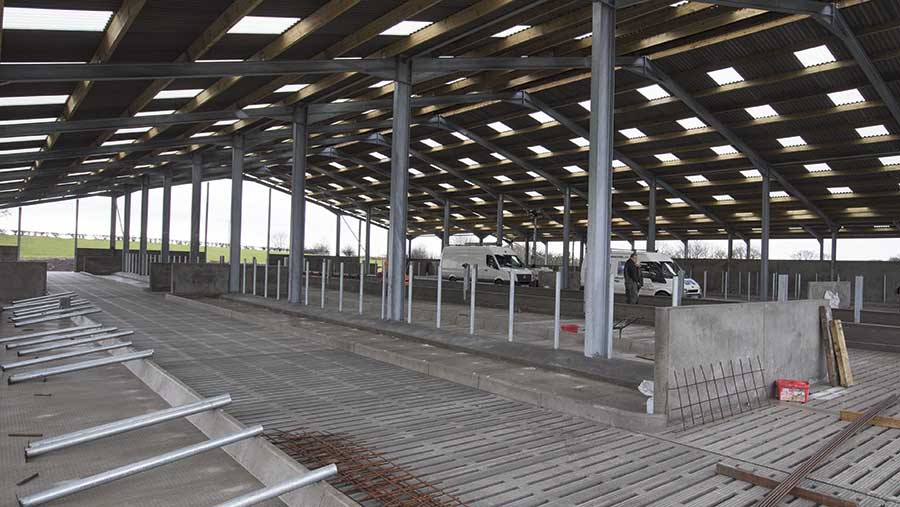How to build a resilient dairy business in volatile times
 © Tim Scrivener
© Tim Scrivener After a strenuous two years, milk prices have finally turned a corner, but fears loom that a spring flush could result in falling farmgate returns once more.
Consultants and analysts warn volatility is here to stay. Good business management and cashflow will be fundamental if producers are to ride out the storm.
Rhian Price spoke to dairy consultants Ian Browne of FCG Agric and Kite’s John Allen to find out what tools can be applied to strengthen the position of your business in these volatile times.
How often should you review budgets and cashflow and what should they include?

Ian Browne
IB Budgets should be drawn up at the beginning of the year (be it calendar or financial year) and they should include a physical and financial plan for the next 12 months.
Once a budget has been drawn up and agreed, it should not be regarded as a job done. The real worth of the budget is in monitoring progress monthly and filling in actual results against original forecasts.
See also: Outlook 2017: Volatility likely to remain for dairy sector
By doing this, a better understanding can be obtained of what has happened and if there are differences, why or how they have come about. For example, if cattle sales are down, is it because the number sold is different to the plan or was the price obtained per animal not as predicted?

John Allen
JA For most UK dairy businesses, best practice is annual budgets with a profit and cashflow forecast reconciled to the balance sheet. You must also include a forecast for breakeven milk price.
Start to put a draft together in January along with doing the tax planning for the year end if it’s in April and have it finalised by March/April.
After that you should have quarterly meetings focused on actual financial results versus budgets. Larger operators may run monthly financial monitoring.
How do you decide where to focus your investments?
IB Having a long-term strategy that clearly outlines what you are trying to achieve over a 10- to 15-year period will help you decide what you should invest in.
This “screening” of a project against goals is what helps good businesses to stay focused and avoid “vanity”-type investments that do not achieve the real goals decided on.
However, these longer-term plans need to be reviewed regularly to ensure they are still fit for purpose.
In terms of knowing what to invest in, it is essential that a good return on the investment is achieved.
|
Type of investment |
Payback period/ROI |
Considerations |
|
Livestock |
Four years/25% |
|
|
Parlour/cubicles |
8-10 years/10-12.5% |
Must take into account all associated costs and savings, as no direct income is achieved |
|
Land |
15-20 years/5-6.5% |
|
If this cannot be achieved, then maybe you should question whether it can really be afforded.
And always remember, the cost of finance may not remain as low as it is now and inflation erodes the benefits gained.
To this end, a 6% interest charge and up to 3% inflation allowance should be made. This means you will require at least 9% net return on investment to just achieve break even.
Realistically, all projects should probably aim at achieving a 15% net return on investment to even be worth considering.
JA Prioritise your investments using partial budgets to set out competing return on investment (ROI). For example, if you buy an extra 20 cows and the capital cost totals £60,000 and the return is £15,000 that will give you an ROI of 25%.
A second project could be extending the slurry storage. However, if this costs £60,000 and saves you £3,000/year in fertiliser, then the ROI will only be 5%.
However, if the extra storage is required to ensure you comply with nitrate vulnerable zone rules, the investment must be made.
Don’t make significant investments without getting independent advice. Sometimes farmers can be too optimistic because they desperately want to do a project or have been sold a deal by a salesperson that is too good to be true.
How much of a cash buffer should you save for volatile times?
IB It is sensible to have a “rainy day” fund of cash in reserve that you can call on to help negotiate the low points of the business cycle. This should be as much as 15% of your main turnover or one to two milk cheques.
JA It depends on the vulnerability of your business. If your breakeven is 28p/litre, you need a bigger buffer than someone whose breakeven is 20p/litre. Therefore the best buffer is a low breakeven milk price.
Other buffers can come in various forms: You can have savings, ISAs, repay debt or reduce your overdraft to give you “headroom” for the next downturn. Avoid non-farm assets that are not “liquid assets” – in other words, that can’t be cashed easily.
As a rule of thumb, you should bank one-third to half of your profit after drawings in good years to strengthen your balance sheet.
How can you best manage loans and overdrafts if you are heavily borrowed?
IB Overdrafts are renegotiated at least annually, for which a charge is levied or arrangement fee taken. More importantly, overdrafts can be called in at very short notice.
Therefore, businesses that are heavily borrowed are those at most risk. The first imperative is to reduce your overdraft and keep up with loan repayments.
Businesses with very high short-term debt may be best advised to restructure existing debt and move hardcore overdrafts to a loan basis.
This helps to give the business better security as loans will not be called in if the payments are kept up to date and is far safer than borrowing on overdraft.
JA If you have fixed-interest loans you have less flexibility, since you will have committed to capital repayments, so be careful since you cannot easily get capital repayment holidays.
If you have high debts and restructuring is critical, do not try to repay capital too quickly since you can end up using an overdraft to repay debt and you will starve yourself of cash. It is cashflow that kills a business.
It is tempting to keep extending your overdraft facility (if the bank allows), but when should you stop?
IB In an ideal world, the overdraft should be no higher than two average milk cheques. When starting this overdraft, the total borrowed should not be up at the limit.
You need to leave yourself enough headroom to function and deal with the seasonal bills. A good budget and cashflow will allow the appropriate level of overdraft to be selected.
JA Getting credit is becoming harder, so it is tempting to use your overdraft.The key thing to remember is that overdrafts are for trading purposes, not capital investments.
Remember they need to be paid on demand. If you use your overdraft to avoid repaying debt, you run the risk of “burning up your balance sheet”.
Should investments only be made when the milk price is good?
IB Realistically a good investment will always be right. If it is correct to make it, then get on and do it, regardless where you are in the cycle. It should be undertaken rapidly – do not wait for the upturn in the cycle or you will miss out on the good times.
JA Definitely not. This is the reason for good financial planning and a resilient business must have the capacity to trade through a downturn. Making investments in bad years can be preferable because you do them more cost-effectively and you can get good deals.
When taking out a new loan, what must I consider?
IB When starting a new loan or renegotiating an existing one, make sure you are realistic about the repayments you can really afford. There is no point in starving yourself of cash or entering a situation whereby the overdraft starts increasing as the loan goes down.
It is better for a loan to be spread over too long a period than repay too rapidly.
JA Make sure the amount covers what you need. For example, if you require £100,000, don’t take out a loan for £80,000 and fund the rest through your overdraft unless you know you have the cash available.
You need to work out if fixed or variable is best and it must suit your business risk profile. If rising interest rates will be damaging to your business, you will want to fix. But once you are fixed you must make those repayments, so make sure you can afford the loans.
